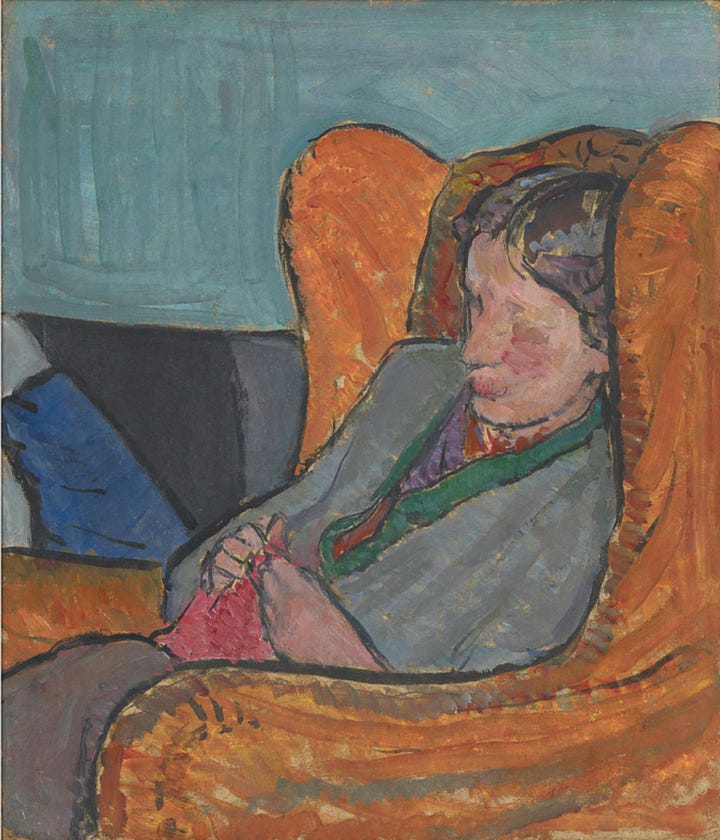Hello everyone. I hope that life is treating you well. This week I’m a bit tired. I’ve spent quite a lot of time supporting a family member who has just accepted that they have been a victim of emotional bullying/violence for 45 years. Unsurprisingly I’ve had trouble sleeping. Husband A’s nose chose this week to develop persistent bleeding involving broken nights with ice cubes and copious amounts of tissues and eventually a trip to the health centre for treatment to stop it. The whole week has left me tired, irritable, dissatisfied and unable to relax. I want to turn inwards. Maybe that’s no bad thing. I’ve been reminding myself that I have to work at relaxing, at slowing, at noticing. So, I picked up my knitting - a sock. It’s so often a sock.
The first few rows are irritating. My hands, increasingly stiff with arthritis, are awkward with the small needles. I contemplate leaving it and doing something else, but, eventually, something changes — I find the stitch pattern’s rhythm. My mood and thoughts loosen themselves between the knit and the purl, the repeating rounds. I think, in a rare moment of perspicacity, of Virginia Woolf and the remark she made in a letter to her shortly-to-be husband, Leonard: “Knitting is the saving of life”. The letter was written in 1912 after a long period of mental ill-health. If anyone understood the importance of time alone, and the quiet rituals that help to stitch a self back together, it is Woolf – even though, for her, they were ultimately unsuccessful.
I have never really considered Woolf as a knitter, I had rather thought that she might despise an activity so often seen as ‘homely women’s work’, although there is a small painting by her sister, Vanessa Bell, showing the writer comfortably slumped in an armchair, hands and eyes engaged in a knitting project. And apparently, Vita Sackville-West used to supply her with wool from the sheep raised at Sissinghurst. Who knew? There is also a wonderfully dismissive remark made by Edith Sitwell after Woolf’'s death: "I enjoyed talking to her, but thought nothing of her writing. I considered her 'a beautiful little knitter.'" I can just imagine that coming from the mouth of the Grande Dame of eccentricity, whose own fabric choices of fabulously opulent furs, silks and velvets were rather more luxurious than hand-knit wool.


Others have connected the craft and the author. There are a couple of academic studies that consider the place of knitting in Woolf’s work: Okumura (2008) suggests that knitting is a metaphor for writing in Woolf's fiction. Stevanato (2017) hypothesises that in the 1925 novel Mrs Dalloway, Clarissa Dalloway and Woolf as the author are both "knitters of patterns", and sees the novel as "a knitted whole" made up from the overlapping threads of the characters' lives. She goes on to comment that in Woolf's 1927 novel To the Lighthouse, the purposeful and calming "female" occupation of knitting is in direct opposition to the pessimistic and destructive "male" activities of war. Both interesting takes, but I don’t know if I see it that way myself.
“A woman must have money and a room of her own if she is to write fiction.”
Woolf’s famous line is often quoted as a call for creative independence, but that ‘room of one’s own’ of which she speaks so persuasively is not just a physical space and an independent income. It’s about time, emotional freedom, a tactile reassurance of personal possibility. In my mind, The Room is not a place for work and study, but somewhere softer – somewhere to engage with a different intellectual rhythm – maybe a seat next to a window; a comfortable sofa with drink and snack to hand; birdsong in the air; a skein of thought unfurling like a skein of yarn. Romantic perhaps, but why not?
And so, it seems, Woolf did knit. But she was also a walker, a watcher, a writer who (if I may make so bold) knew the same rhythms as I do, of long thoughts unfolding slowly. Those rhythms — steps or views, or the steady work of needles — creates space for ideas to rise and settle, and for calm to descend. Writing and knitting are both activities of repetition, patience, and a tolerance for re-making or starting over.
This weekend I knit because I need a rhythm that isn't governed by algorithms, or by other people’s needs. I knit while checking Substack; I knit while watching TV; I knit chatting to A. And I knit because it makes the world smaller and slower for a moment. It’s not so different from writing. A line, then another. A row. A page. A purposeful creation of resilience.
Thank you for reading. Take care and I’ll write again soon x.






I'm in complete agreement with VW and yourself. I knit almost every day. It is a comfort and enables me to quiet my over busy brain.
A gorgeous final paragraph, June, as if the knitting rhythm really is driving the lovely writing.